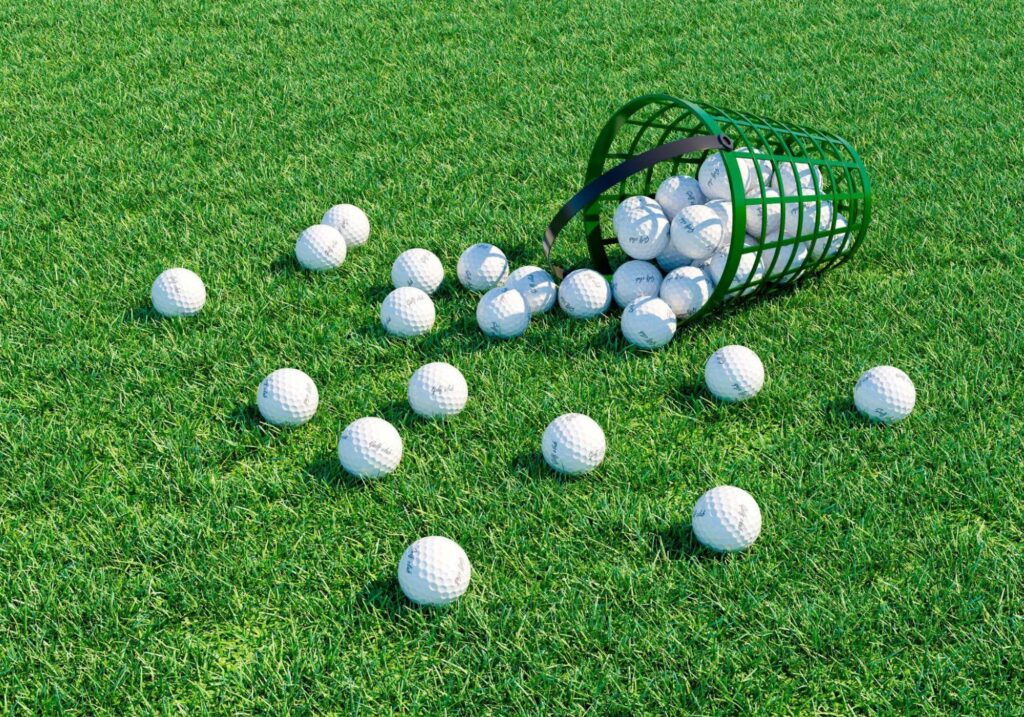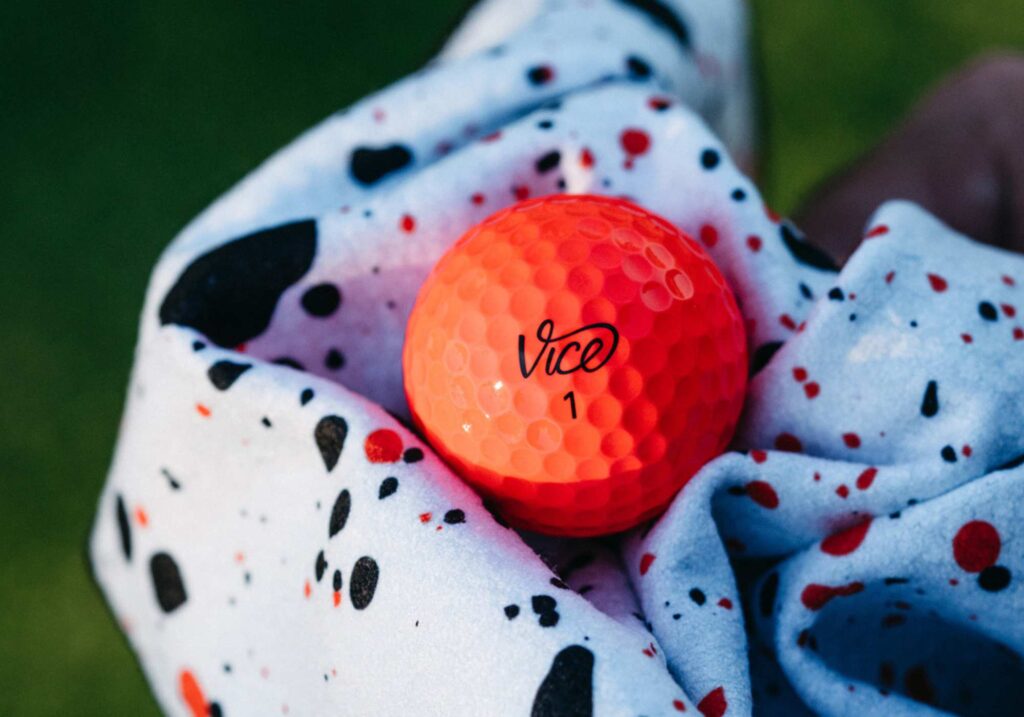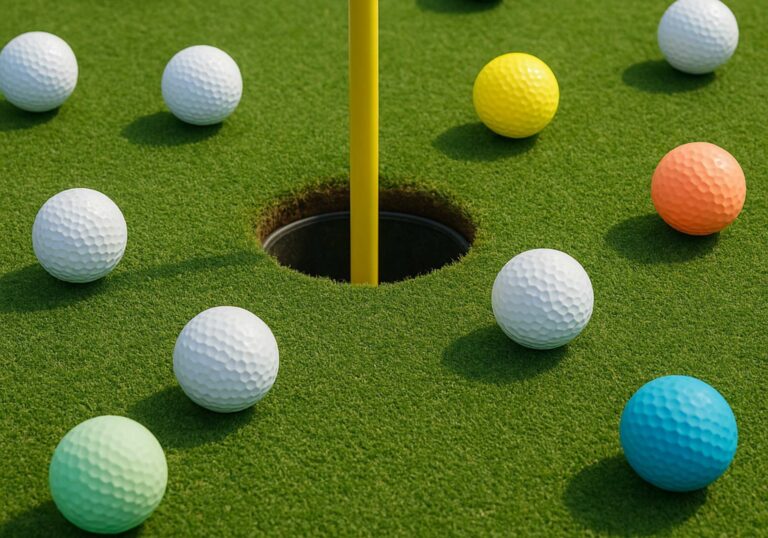Everything you need to understand about the little white (or yellow, or matte pink) thing that makes the whole game go
So… why does the golf ball matter?
It might seem like all golf balls are the same. After all, they’re small, round and usually white. But here’s the truth: the golf ball is the only piece of equipment you use on every single shot. It’s your constant companion, whether you’re piping a drive, finessing a wedge, or nervously lining up a 3-footer to save par.
And golf balls are definitely not all created equal. From how they’re built to how they spin, fly, and feel, there’s a lot going on beneath that dimpled surface.
Let’s walk through the key golf ball terms and concepts that will help you pick the right one and actually understand what your playing partners are talking about when they say “I need more greenside spin” or “this ball feels clicky.”
Core Golf Ball Terms (Literally)
Core
This is the innermost part of the golf ball. Think of it like the engine. It’s typically made from synthetic rubber and is designed to help with speed and energy transfer.
Why it matters: A firmer core usually leads to higher ball speed and more distance, especially for faster swingers. A softer core often feels better and can help reduce spin off the driver.
Compression
This refers to how much the ball compresses against the clubface at impact. Compression is typically rated on a scale, usually 30 to 110.
Low Compression (30 to 60): Softer feel, more forgiveness, typically known for being better for slower swing speeds
Mid Compression (60 to 90): Balanced performance for many golfers
High Compression (90 to 110): More control and speed potential for fast swing speeds
Why it matters: If your swing speed is slower, a lower compression ball can help you launch it higher and get more carry. Faster swingers often benefit from firmer balls with higher compression.
It is worth noting that not all brands use the same machines or methods to measure compression, this means there are variances in these numbers across all brands.
Layers (also called Construction)
Golf balls come in different constructions: 2-piece, 3-piece, 4-piece, or even 5-piece designs.
2-piece: Simple and durable. Great for beginners who need distance and value. Less spin
3-piece: Adds a mantle layer for improved feel and control around the green
4-piece or 5-piece: Offers the best blend of distance, spin separation, and feel. Preferred by skilled or high-swing-speed players
Why it matters: More layers means more versatility but also a higher price. For most new players, a 2- or 3-piece ball is a great starting point.
Cover
The outer shell of the ball. Usually made from Surlyn or Urethane.
Surlyn: Durable, lower cost, less spin. Found on most distance and value balls
Urethane: Softer feel, more spin on wedges and short shots. Used in premium balls like the Titleist Pro V1 or TaylorMade TP5
Why it matters: If you care about short-game spin and soft feel, urethane is the way to go. But if you lose balls often, Surlyn might save your wallet.
Dimples
Those little indentations on the surface aren’t just for looks. Dimples reduce air drag and help the ball fly farther and more predictably.
Most balls have between 300 and 400 dimples
Different patterns affect trajectory and stability
Why it matters: You don’t need to obsess over the exact number, but dimples are the reason your ball doesn’t fly like a knuckleball.

Performance Terms You’ll Hear on the Course
Spin Rate
This measures how fast the ball spins in the air after impact. It’s crucial for control and distance.
Driver spin: Lower (to an extent) is better for distance
Wedge spin: Higher (again, to an extent) is better for stopping power on the green
Why it matters: High spin can help the ball stop quickly on the green, but too much spin with a driver can balloon your shots and kill distance. It is a balancing act.
Launch Angle
How high the ball comes off the face at impact. Golf ball design can influence this.
Why it matters: A low-launch ball will flight lower and roll more. A high-launch ball will carry farther and stop quicker. Match it to your swing and course conditions.
Feel
A very subjective but important term. “Feel” refers to the sensation at impact or how soft, firm, or clicky the ball is on full swings and putts.
Soft feel: Preferred by many players, especially on short shots and putts
Firm feel: Often leads to more feedback and can be longer off the tee
Why it matters: Confidence matters. If a ball feels off to you, you probably won’t trust it on the green.
Greenside Spin
This is spin generated on short chips and pitches around the green.
Why it matters: More spin means more control. Urethane-covered balls typically offer more greenside spin than Surlyn-covered ones.

Common Golf Ball Descriptions and What They Mean
Distance Ball
Built to go far. Usually lower spin, harder cover and optimized for straight flight.
Great for: Beginners, high-handicappers and players who just want to get the ball down the fairway.
Tour Ball or Premium Ball
Used by pros and better amateurs. Higher compression, urethane cover, multi-layer design.
Great for: Skilled players who want control, spin and all-around performance.
Low-Spin Ball
Reduces side spin and backspin. Helps fight slices and maximize rollout.
Great for: Players who struggle with slicing or spinning the ball too much off the tee.
High-Spin Ball
Increases backspin, often better for wedge shots and greenside control.
Great for: Short-game lovers or players who want to stop the ball quickly on approach.
Soft Ball
Usually lower compression and softer cover. Emphasis on feel and forgiveness.
Great for: Slower swing speeds or anyone who prefers a softer feel on chips and putts.

Bonus Terms and Fun Facts
Ball Fitting
Just like club fitting, some companies offer ball fittings to match your swing and preferences to a specific ball model.
Worth trying if you’re curious about dialing in your gear.
Reloads or Refurbished Balls
Balls that were lost, collected, cleaned, and re-sold. Cheap, but sometimes performance can be inconsistent.
A decent option for newer golfers who go through a lot of balls.
Tour-Level vs Amateur
These are loose terms, but generally:
Tour-level means high spin, urethane, multi-layer
Amateur or value means lower spin, Surlyn, simpler construction
So… Which Ball Should You Use?
Here’s a quick cheat sheet:
| If you are… | Try a ball that… |
|---|---|
| Losing balls often | Is durable and affordable (2-piece) |
| New to golf | Is soft, low compression |
| Swinging slow (under 90 mph) | Has low-mid compression |
| Needing more control around green | Has urethane cover, mid/high spin |
| Playing in wind a lot | Is low spin, stable flight |
| A confident striker chasing edge | Tour-level urethane ball |
Final Thoughts: Don’t Overthink It (Yet)
Golf balls are important, but you don’t need to drop $50 a dozen to enjoy the game. Start with something that fits your budget, feels good, and performs well enough. As your game grows, you can experiment and even get fit for a ball just like you would your clubs.
The goal is to find one that feels right, flies true, and gives you confidence from tee to green.
Got Questions or a Favorite Golf Ball?
Drop your comments below. Whether you love a cheap Surlyn two-piece or swear by a Pro V1, we’d love to hear why. The ball you trust says a lot about your game, and your feedback helps others find theirs.

1 Comment
Thanks for the info on golf balls. I am 81 years old; hit my driver a little over 200 yds. I tried 4 balls last year. I get them from Lost balls. I buy the pristine ones. Tried ProV1; Chrome soft; Strixon soft feel; and Titleist tour soft. I have decided the tour soft works best for me and my game. The prov1 holds the green better on wedge shots, but the tour soft overall are best for me. I am a11 handicap at our club.